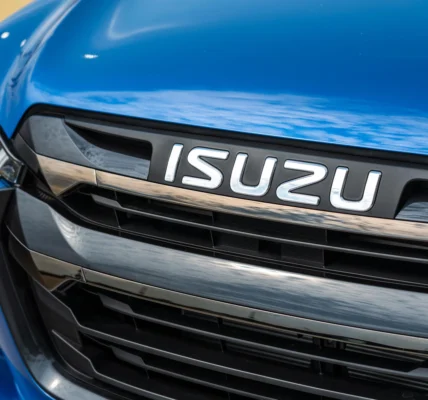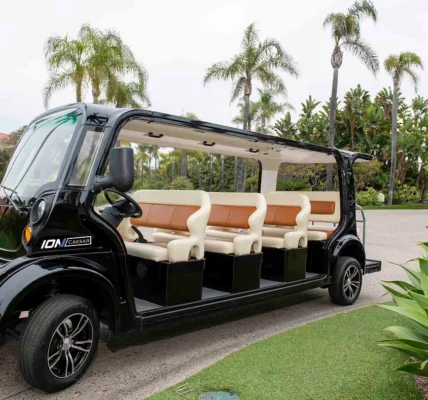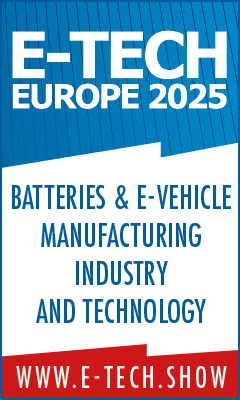Volkswagen’s premium midsize sedan ID.7—the brand’s new flagship EV (earlier post)—will be launched around the world. The new Volkswagen can now be ordered in Europe; a 282-hp ID.7 Pro with 82kWh (gross) battery offers a Worldwide Harmonized Light Vehicles Test Procedure (WLTP) range of up to 386 miles (621 kilometers).
The ID.7 for the European and North American markets will be produced in Volkswagen’s electric mobility factory in Emden, Germany.
The launch version of the ID.7 will be available with a new, efficient drive system, known within Volkswagen as APP 550. (Earlier post.) The new electric motor is the central module of this drive unit. It is the most powerful and highest-torque electric drive motor in a Volkswagen EV model so far. It forms a module that is integrated into the rear axle together with the dual-stage one-speed gearbox and pulse inverter.
The lithium-ion battery located in the sandwich floor is responsible for energy supply in the ID.7. On board the launch version, the battery offers a net energy content of 82 kWh (gross). While the vehicle is on the road, a new charging and thermal management function makes sure the battery is pre-conditioned ahead of the next DC charging stop.
With this pre-conditioning, the ID.7 is supplied with energy again as quickly as possible. The battery is brought to the optimum temperature ahead of the charging stop so that it can be charged at maximum power. This enables the charging time to be reduced by several minutes, particularly in winter.
When route guidance on the navigation system with the Electric Vehicle Route Planner is active, pre-conditioning is started automatically on the way to the next quick-charging station. Without active route guidance, the function can also be manually activated using the charging menu in the infotainment system.
The essential elements of the drivetrain are the three-phase permanent magnet synchronous motor, the two-stage one-speed gearbox, and the inverter (power and control electronics). The increased power and efficiency of the electric motor in the ID.7 are the result of details such as:a rotor with strong permanent magnets that offer a high thermal load capacity;an improved stator with a large effective number of windings in combination with maximum wire cross-section; a water heat sink for the outside of the stator; anda new, combined oil and water cooling system that also ensures higher thermal stability.
The thermal stability is safeguarded by a new inverter generation, and the higher thermal load capacity is an elementary contributing factor to the increased efficiency of the new powertrain. Numerous gearbox components have also been friction-optimized and reinforced, and thus adapted to the high power and torque values.
Volkswagen developed the new inverter, including its software, entirely in-house. The module is multi-faceted: for example, it converts the direct current (DC) stored in the battery into the three-phase alternating current (AC) needed by the electric motor. It also controls the complete energy flow between the battery and motor. Any acceleration or recuperation is processed by this electronic brain.
During recuperation, the inverter converts the generated alternating current into direct current that is then stored in the battery. It additionally monitors the temperature of the electric motor.Chassis. The ID.7 is a comfortable sedan, with balanced damping and a long wheelbase offering a high level of comfort in all driving situations. It also offers sporty handling, due to the basic layout of the running gear, the optional DCC adaptive damping system and a newly developed vehicle dynamics manager.The comfort in the ID.7 is further optimized by details such as specifically tuned, high-damping mounts for the rear axle. In addition, the integration of the battery in the vehicle floor gives a low center of gravity that also has a positive impact on handling.
The basic layout of the running gear consists of strut-type front suspension and a five-link rear axle. The control system for the optional DCC system has also been refined with new Volkswagen software that uses refined algorithms to control the dampers. With DCC, the driver has the option of adjusting the running gear to a sporty or more comfortable setting by means of the selected driving profile (Eco, Comfort and Sport) and also in Individual mode by means of a slide control.In addition, a new setup for the vehicle dynamics manager makes this large spread between comfort and agility possible. The vehicle dynamics manager coordinates and optimizes the lateral dynamics as the central control unit and continuously ensures maximum driving stability (when braking into a bend, for example).
The steering system was also reconfigured for the ID.7. The new setup responds more directly on center, allowing more precise control. This further improves Volkswagen’s typically linear handling. With the optional progressive steering, more dynamic vehicle reactions are possible with smaller changes of the steering angle, delivering even more enjoyment behind the wheel.
Interior and technology. With its long wheelbase and the compact drivetrain, the ID.7 offers a great deal of space in both rows of seats. This is particularly evident in the rear with the generous legroom. Despite the battery being integrated into the vehicle floor and the lower body height compared to all other ID. models, the ID.7 still offers good headroom of 40.4 in at the front with the panoramic roof and 37.8 in at the rear. The electric trunklid allows access to a luggage compartment with up to 18.8 cu ft of capacity; when loaded up to the first row of seats, the volume increases to up to 56.0 cu ft.This Volkswagen is equipped as standard with an augmented-reality (AR) head-up display. It projects any information relevant to the journey into the driver’s field of vision, so they no longer have to take their eyes off the road. At the same time, the new AR head-up display changes the cockpit layout by using much smaller traditional instrumentation. This ID. Cockpit display is at the same level as the air vents and shows standard information, such as speed and warnings. The small ID. Cockpit also means the driver’s eyes focus on the AR head-up display and, as such, what is happening on the road.
Via the AR head-up display, information such as speed, lane markings, distance warnings and turn arrows from the navigation system are blended into the driver’s line of sight. Information such as the current and maximum permitted speeds are projected into the close range (3.8 yards in front of the vehicle). In contrast, the system projects journey-relevant information and current instructions from the navigation system into the far range (about 10.4 yards in front of the vehicle). The status bar in the AR head-up display also shows information such as the battery charge level and consumption.
The AR area of the head-up display also has a new feature: lane-level navigation, which can help guide the driver into the right lane for a freeway junction at an early stage, for example. The standard ID. Light function (strip of light under the windscreen) provides the driver with intuitive information.The central interface between human and machine is the all-new 15-inch infotainment touchscreen display. The graphic interface and menu navigation have been largely restructured. The aim was to make operation of all functions as intuitive and customizable as possible. For this purpose, the display has been
divided into two permanently visible strips (one at the top and the other at the bottom) and the home screen.A new direct access key on the left of the display’s top bar lets the user open the main menu with an overview of all apps. Next to this is a button for the new Car Control Center, which offers direct access to the most important vehicle functions and can be configured individually by the driver. The main menu and Car Control Center are always accessible without having to close the active app. This makes the system easy to use. To the right of the Car Control Center are five additional direct access keys, to which users can freely assign available apps. As a result, the driver and front passenger can quickly and easily switch between their favorite and frequently used apps.The home screen in the middle combines the content of the most important apps on differently sized tiles. The home screen can also be individually configured by the user. Here, the layout and number of pages can be adapted in addition to the content of the tiles.The bottom bar on the display contains the air conditioning and seat functions and has a home button that lets the driver return to the central home screen at any time. This means the air conditioning menu, temperature settings for the driver and front passenger and configurable air conditioning functions can always be accessed directly.Two decades ago, Volkswagen presented one of the cutting-edge air conditioning systems in the world at that time in the Phaeton luxury sedan. This offered practically draft-free ventilation, and the vents opened and closed automatically. The ID.7 now offers active electronic control of the air vents. Smart air vents with electronically controlled vertical and horizontal motors open and close automatically and distribute the air quickly over a large area of the interior, using dynamic movements.
Provided the function is activated, cooling or heating already starts as soon as the driver approaches the ID.7 with their key. The air flow can be adjusted individually in the interior by corresponding settings in the central infotainment system display.Driver assistance. Park Assist Plus and the memory function for Park Assist come as standard. Park Assist Plus is a system that is already familiar from other Volkswagen models: it enables the driver to receive assistance when driving into or out of parking spots. The vehicle takes over control of acceleration, braking and steering for this purpose. The new Volkswagen is equipped with the memory function for Park Assist. This is not intended for use in moving traffic on public roads, but for parking on private property. With the memory function, the system always records the last 54 or so yards of a journey and thus records the parking situation.
The parking maneuver can be saved by the driver when the vehicle has come to a stop. When the ID.7 then reaches the same location again—for example, the entrance to a garage or a parking space at work—it automatically offers to take over parking independently. Automatic driving out of a parking space is also possible with the memory function. A total of five parking maneuvers can be saved at a wide array of locations.
Newly enhanced Travel Assist, in conjunction with Park Assist Plus and Side Assist, which are also included in the ID.7 as standard, facilitates assisted lane changing when travelling on multi-lane freeways at speeds above 56 mph. Adaptive lane guidance has been enhanced. When Travel Assist is active, it predictively integrates upcoming parameters, such as corners, roundabouts and junctions, into vehicle control and the displays. For example, if there is a corner ahead and the set speed is too high for taking the corner, the system shows the message ‘Corner ahead’ along with a recommended speed.
Assisted lane changing on freeways visually offers the driver a lane change if this is permitted by the traffic situation. If the driver then activates the left or right turn signal, an independent lane change is performed in the corresponding direction within the limits of the system. Drivers must keep their hands on the steering wheel during this process.When a vehicle door is opened, the new exit warning system warns passengers of vehicles of any kind approaching from behind—including bicycles—and can thus help to avoid a collision. This new function is a system enhancement of the Side Assist (lane change assist) system. The exit warning system detects objects in a defined area to the side of and behind the Volkswagen. There are two different warnings: a visual warning via the Side Assist LEDs in the exterior mirror and an acoustic one. The door opening process is delayed at the same time.








